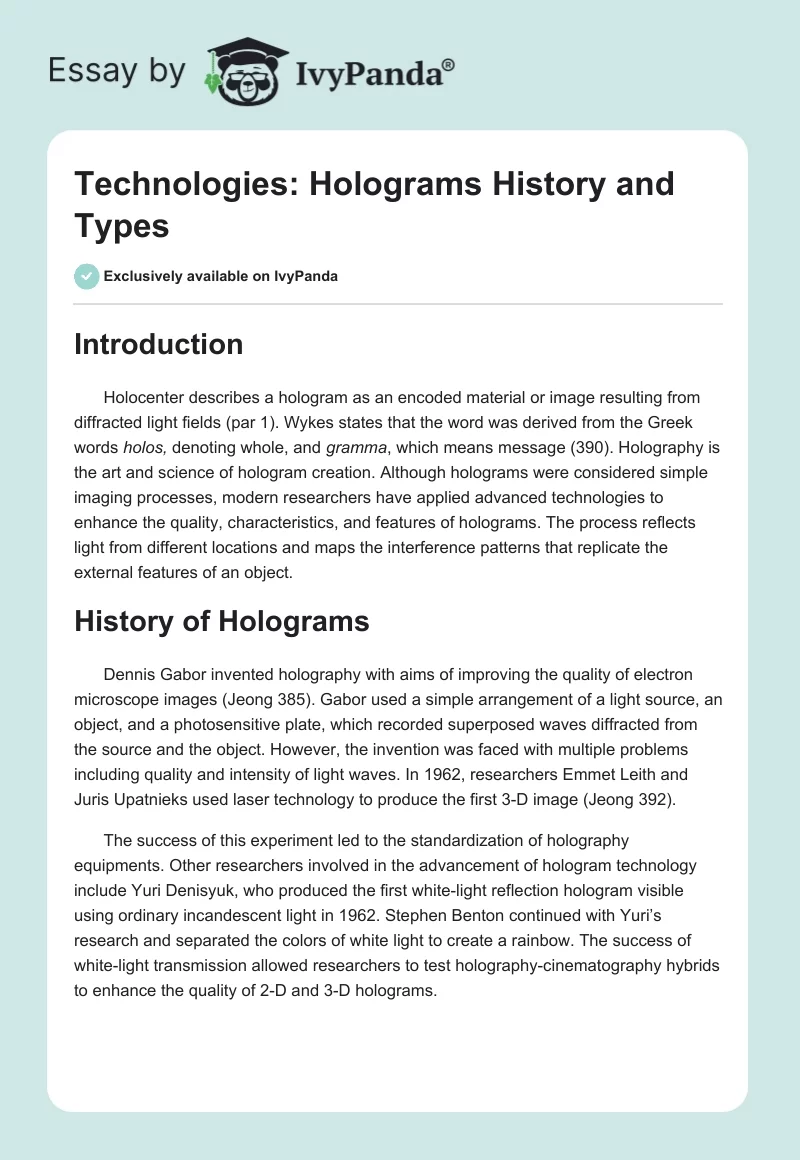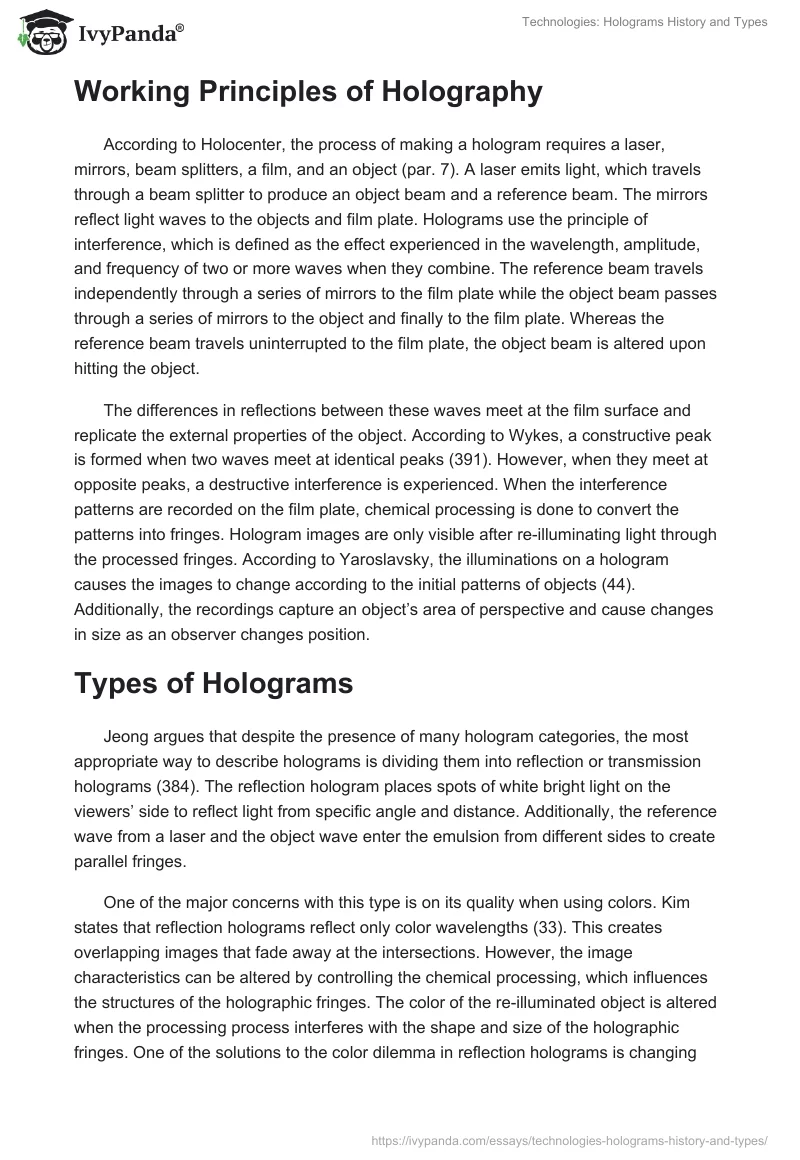Introduction
Holocenter describes a hologram as an encoded material or image resulting from diffracted light fields (par 1). Wykes states that the word was derived from the Greek words holos, denoting whole, and gramma, which means message (390). Holography is the art and science of hologram creation. Although holograms were considered simple imaging processes, modern researchers have applied advanced technologies to enhance the quality, characteristics, and features of holograms. The process reflects light from different locations and maps the interference patterns that replicate the external features of an object.
History of Holograms
Dennis Gabor invented holography with aims of improving the quality of electron microscope images (Jeong 385). Gabor used a simple arrangement of a light source, an object, and a photosensitive plate, which recorded superposed waves diffracted from the source and the object. However, the invention was faced with multiple problems including quality and intensity of light waves. In 1962, researchers Emmet Leith and Juris Upatnieks used laser technology to produce the first 3-D image (Jeong 392).
The success of this experiment led to the standardization of holography equipments. Other researchers involved in the advancement of hologram technology include Yuri Denisyuk, who produced the first white-light reflection hologram visible using ordinary incandescent light in 1962. Stephen Benton continued with Yuri’s research and separated the colors of white light to create a rainbow. The success of white-light transmission allowed researchers to test holography-cinematography hybrids to enhance the quality of 2-D and 3-D holograms.
Working Principles of Holography
According to Holocenter, the process of making a hologram requires a laser, mirrors, beam splitters, a film, and an object (par. 7). A laser emits light, which travels through a beam splitter to produce an object beam and a reference beam. The mirrors reflect light waves to the objects and film plate. Holograms use the principle of interference, which is defined as the effect experienced in the wavelength, amplitude, and frequency of two or more waves when they combine. The reference beam travels independently through a series of mirrors to the film plate while the object beam passes through a series of mirrors to the object and finally to the film plate. Whereas the reference beam travels uninterrupted to the film plate, the object beam is altered upon hitting the object.
The differences in reflections between these waves meet at the film surface and replicate the external properties of the object. According to Wykes, a constructive peak is formed when two waves meet at identical peaks (391). However, when they meet at opposite peaks, a destructive interference is experienced. When the interference patterns are recorded on the film plate, chemical processing is done to convert the patterns into fringes. Hologram images are only visible after re-illuminating light through the processed fringes. According to Yaroslavsky, the illuminations on a hologram causes the images to change according to the initial patterns of objects (44). Additionally, the recordings capture an object’s area of perspective and cause changes in size as an observer changes position.
Types of Holograms
Jeong argues that despite the presence of many hologram categories, the most appropriate way to describe holograms is dividing them into reflection or transmission holograms (384). The reflection hologram places spots of white bright light on the viewers’ side to reflect light from specific angle and distance. Additionally, the reference wave from a laser and the object wave enter the emulsion from different sides to create parallel fringes.
One of the major concerns with this type is on its quality when using colors. Kim states that reflection holograms reflect only color wavelengths (33). This creates overlapping images that fade away at the intersections. However, the image characteristics can be altered by controlling the chemical processing, which influences the structures of the holographic fringes. The color of the re-illuminated object is altered when the processing process interferes with the shape and size of the holographic fringes. One of the solutions to the color dilemma in reflection holograms is changing the size of the emulsions to alter the fringe spacing and transfer the appropriate color to the final image.
In the transmission hologram, light emerges from behind an object while the image is conveyed to the observer’s side. One of the major characteristics of a transmission hologram is the high intensity of images that are only viewed using laser lights. Additionally, this form of technique creates perpendicular patterns between the reference and object wave. According to Holocenter, this type is also referred to as laser viewable transmission hologram (par. 13). The process faces color challenges because of the varying wavelengths of color. For example, the wavelengths of the blue color are shorter than most of other primary colors in the grid. A solution to this problem is realized using geometric alterations, which diffract all available colors to the image. Achromatic angles separate and recombine colors at the film plate to produce white-only or color mixed images.
Forms and Application of Holographs
Holograms form when reflections from a static body are diffracted onto a film plate. However, holography dealing with live subjects requires the use of pulse lasers, which produce ultrashort flashes that freeze a body’s motion and records reflections analogous to static bodies. Holographic interferometry is another popular form that detects the smallest variations in the form to map onto the film plate. Researchers have used this technology in industrial tests and advanced holography to map potential breath movements and blood flow under human skins.
The hologram’s concept of reflection and interference has been used to construct holographic optical elements. Multiple holographic optical elements are arranged in a holography sequence to create aesthetic abstract images. Similarly, the elements have been used commercially in lighting design and video projection screens. Multiplex holography is applied in animation and stereopsis using multiple holographic exposures on a master frame (Holocenter par. 15).
In one complex holograph, Lloyd Cross combined cinematographic and holographic techniques to create a holography loop. The technology has been used in printing to develop dot-matrix holograms that create images using diffractive pixels. The strategy uses angles to diffract light strategically according to different color spectrums. One of the consequences of this strategy is the lack of 3-d depth information because it only contains bright tilting colors. The concept is referred to as a decorative light architecture because of high-density colors on a 2-D surface.
Modern holography utilizes computer-generated fringe patterns using tested color pixels. Every color is represented in pixels, which can be stored and replicated in the regions of a film. Movie producers map the intensity of every color, line, and thickness using software and special light modulators. Barcode scanners utilize holographic lenses that use reflection technology to decode product information.
Modern holography has led to the development of a touchable 3-D hologram using UltraHaptics. According to Philips, UltraHaptics uses ultrasound waves and condenses them to create a pressure illusion of touchable holographs (par. 2). The author argues that the technology is essential for creating virtually touchable images of patients’ internal organs during surgery (par. 3). Additionally, the touch technology is considered a breakthrough in creating touchable floating 3-D objects (par. 6). The technology is expected to revolutionize optical communication and transfer of data from one digital location to another.
Conclusion
Holograms use laser light reflections to direct two beams to an emulsion that records interference patterns and maps an object image onto a film plate. Although traditional holography used simple light fields to enhance the quality of microscope images, modern technologies have generated clearer 3-D images using laser light. Different types of holography have demonstrated significant challenges when dealing with colored objects. However, chemical and geometrical adjustments have been successful in mapping object colors onto images.
Works Cited
Holocenter. What is a Hologram. n.d. Web.
Jeong, Tung. “Basic principles and applications of holography.” Fundamentals Of Photonics 1.10 (2000): 381-417. Print.
Kim, Myung. “Principles of Holography.” Digital Holographic Microscopy 162 (2011): 29-42. Print.
Philips, Catherine. Scientists Invent 3D Holograms That You Can Touch. 2014. Web.
Wykes, Catherine. “Introduction to Holography, by Vincent Toal: Scope: monograph. Level: postgraduate, advanced undergraduate, researcher.” Contemporary Physics 53.4 (2012): 390-391. Print.
Yaroslavsky, Leonid. Introduction to digital holography. Sharjah, United Arab Emirates: Bentham Science Publishers, 2009. Print.


